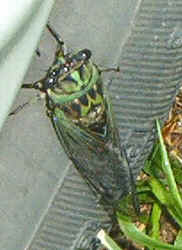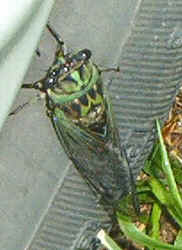 |
 |
Cicada
Scientific Name: Magicicada
Family Name: Cicadidae
Saluda, North Carolina
 |
 |
Large insects, mostly 1-2 inches. Forewings membranous. Males usually with sound-producing organs at base of abdomen on ventral side. Nonjumping insects. Cicadas are common insects, but are more often heard than seen since the majority are arboreal. Song is produced only by males, and is usually a loud (sometimes pulsating) buzz. Most cicadas are large blackish insets, often with greenish markings, that appear each year in July and August; their life cycle lasts 2-5 or more years, but the broods overlap and adults are present each year. The periodical cicadas (Magicicada) have a life cycle of 13 or 17 years, and adults are present in a given area only in certain years. These cicadas occur in the East, and adults appear in May and June; they are 19-33 mm. and have the eyes and wing veins reddish. The 17-year cicadas (3 species) are principally northern. The 13-year cicadas (3 species) are principally southern. The species in each life-cycle group differ in size, color, and song; most emerging broods of periodical cicadas contain 2 or 3 species. Eggs are laid in twigs, which usually die and break off; nymphs live in the ground and feed on roots. Nymphs are stout-bodied, brownish, with expanded front tibiae; they usually crawl up on a tree trunk for their molt to the adult. cicadas are generally of little economic importance, but the egg laying of large numbers of periodical cicadas often causes serious damage to young trees. [Borror, Donald J. and White, Richard E., Peterson Field Guide Series: A Field Guide to the Insects of America North of Mexico, Houghton Mifflin Companym, Boston, 1970]